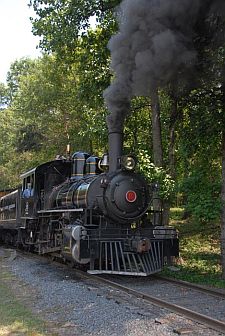By Sam Churchill
Sometimes a man and a machine take to each other at first sight.
That’s the way it was with Old 38 and me as I watched her swing into a curve with jabs of black smoke and steam blasting from her stack.
 Behind her a 50-car train of hemlock logs, fresh from the fringes of Washington’s rain forest, squealed along the 110 pound rail in protest. As the big locomotive came out of the curve we stared at each other, face-to-face. She, a bellowing 293,000-pound giant of steel and steam, me, a 175 pound intruder in her forest domain.
Behind her a 50-car train of hemlock logs, fresh from the fringes of Washington’s rain forest, squealed along the 110 pound rail in protest. As the big locomotive came out of the curve we stared at each other, face-to-face. She, a bellowing 293,000-pound giant of steel and steam, me, a 175 pound intruder in her forest domain.
For a moment there was a fearful feeling of panic that she might thunder right on by. But suddenly the leaping clouds of smoke and steam settled lazily around her stack. There was a sharp hiss of air as brake shoes ground against wheels. Steam squirmed from her four massive cylinders and Old 38 wheezed to a stop.
“Are you the fellow riding with us?” a voice bellowed from the gangway between tender and cab. I nodded and made a grab for the handrail. A long arm reached down from the deck and suddenly I was standing in the pounding, thumping, sizzling world of a steam locomotive cab.
To the uninitiated a locomotive cab can be a frightening thing. Glaring at you through a half covered peephole in the firebox door is a white hot inferno of burning oil that rumbles and shudders like an angry volcano.
Heaving a trainload of logs out of the Crane Creek area of Washington State’s Olympic Peninsula, Old 38 burns 100 gallons of bunker oil fuel an hour. The owner of the long arm that hoisted me into the cab wiped his hands on a piece of engine waste.
He extended a fresh-wiped hand. “My name’s Clark Baldwin,” he said. “I’m head brakeman. Used to go to school in Yakima. You don’t happen to know a fellow by the name of Roy Gano?”
“A dairyman up the Wenas?”
“That’s him. Say hello for me.”
The voice of the train dispatcher, metallic and calm, boomed out from the speaker of the radio receiver bolted to a special bracket in the cab. It reeled off a list of instructions.
Engineer T.C. (Buster) Corrigan picked up a handset, repeated the orders and confirmed the call. Fireman Lee Hoven gave a couple of tugs on the bell cord and Corrigan reached for the whistle lever bolted to the roof of the cab. A tremendous burst of sound, low, sweet and musical as the notes from a pipe organ rolled out across the cloudless sweep of this vast outdoors.
A gentle tug on the throttle bar and Old 38, brought from the Sierra Railroad Company in California in 1955, began to move. The rumble in the firebox jumped to a roar.
As she thundered her way across the Humptulips River bridge, Baldwin tapped me on the shoulder. “Come out on the tender and you can get some pictures,” he yelled. In the cab of old 38 when she’s working a load you don’t talk – you yell to make yourself heard.
With Baldwin leading the way, I crawled out on the top of the bobbing tender and stood braced against an anchored reel of steam hose. Around a curve and strung out across the length of steel pile trestling and bridge girders the loaded log cars swung gently as they followed along the dips of the roadbed.
Somewhere back there, hidden by other curves, was the caboose with a crew of old railroaders taking a last ride behind old 38. Groups of camera fans and steam locomotive lovers began showing up, perched in trees, grouped on stumps and other vantage points. Old 38 gave them a cheery blast from her whistle and kept plunging on.

She didn’t know on this March 31 day in 1962 as did some 3,000 others from as far away as Norway, South Carolina and Ohio, that this was her last run. Her owners, Rayonier Inc. were retiring her and seven others and replacing them with two haughty efficient, wheeled machines called diesels.
A few miles down the track the train dispatcher’s voice would bring old 38 to a halt. She would be uncoupled from her beloved train in front of a specially built speakers’ stand between the tracks and automobile-jammed U.S. Highway 101, some 15 miles north of Hoquiam, Washington.
There would be speeches and sadness and words of praise for old 38 and her kind. Old 38 would then move out of the way, slowly and alone, onto a spur track. The waiting diesel would move into position and take its place at the head of the train.
Everything was carried out as planned. When it was all over and as the diesel throbbed mightily and headed on down the track, old 38 gave it a warm, friendly salute from her whistle.
She was a lady, was old 38. Right up to the last.

- Next Story: Silk Train
- Return: Home
Very Nice. The 38 is one of my favorite steam machines. I had a brass model of her in my model railroad days in my 20s. She still exists in a steam locomotive graveyard in Merrill, Oregon. She is in pieces, but I am told is all there, Maybe someday….